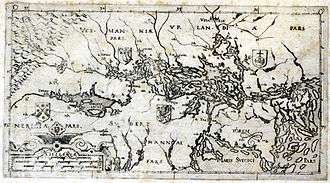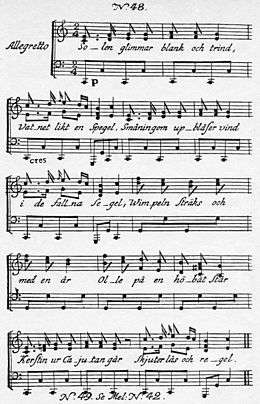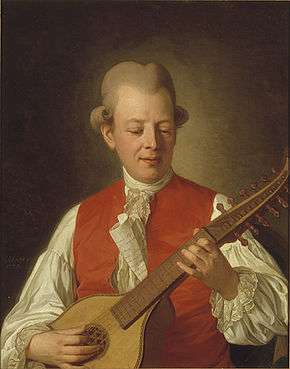Solen glimmar blank och trind

Solen glimmar blank och trind (The sun gleams smooth and round), is one of the Swedish poet and performer Carl Michael Bellman's best-known and best-loved songs, from his 1790 collection, Fredman's Epistles, where it is No. 48. It depicts an early morning on Lake Mälaren, as the Rococo muse Ulla Winblad sails back home to Stockholm after a night spent partying on the lake.[1]
The epistle is subtitled "Hvaruti afmålas Ulla Winblads hemresa från Hessingen i Mälaren en sommarmorgon 1769" (In which is depicted Ulla Winblad's journey home from Hessingen).
Context

Carl Michael Bellman is the central figure in Swedish song, known for his 1790 Fredman's Songs and his 1791 Fredman's Epistles. He played the cittern, accompanying himself as he performed his songs at the royal court.[2]
Jean Fredman is a fictional character and the supposed narrator in Bellman's epistles and songs, based on a real watchmaker of Bellman's Stockholm.[3] The epistles paint a picture of the demimonde life of the city during the eighteenth century, where strong drink and beautiful "nymphs" like Ulla Winblad create a rococo picture of life, blending classical allusion and pastoral description with harsh reality.[2][3]
Song

 |
Melody of Epistle 48
|
| Problems playing this file? See media help. | |
The song is in the key of C, in 2/4 time. It has 21 verses, each of eight lines. The rhyming pattern is ABAB-CCCB. It has a "gay dancing melody", which along with the poem gives the listener[3]
an irresistible impression of being himself present at the song's conception; seems to catch the dashing rhythm of the vessel as it plunges through the waves, to be listening to the voice of the poet where he sits in the stern, improvising his stanza out of the raw materials of the passing moment."
The melody was a favourite of Bellman's, and is of French origin, where it had been used by Antoine de Bourbon.[1]
The Epistle depicts a charming picture of an early morning on Lake Mälaren, as the Rococo muse Ulla Winblad sails back home to Stockholm. The song brings in Movitz the cellist, another of Bellman's stock characters in Fredman's Epistles, based on one of his friends.[3]
The song tells the story of a boat on the way home after a night out on the island-studded lake. In the boat are the peasant girl Marjo, a tub of butter on her knees, with a cargo of the birch-sprigs that Stockholmers used to decorate their town with as a sign of returning spring, milk, and lambs; and her father, puffing his pipe self-importantly at the helm. It begins:[3][4]
| Swedish | Prose translation |
|---|---|
| Solen glimmar blank och trind, Vattnet likt en spegel; Småningom upblåser vind I de fallna segel; Vimpeln sträcks, och med en år Olle på en Höbåt står; Kerstin ur Kajutan går, Skjuter lås och regel. | The sun gleams smooth and round, Water like a mirror; Gradually the wind blows up In the fallen sails; The pennant stretches, and with an oar Olle stands on a hayboat; Kerstin from the cabin steps, Locks and bolts the door. |
Reception

Students of Swedish literature are expected to study Fredman's Songs and Epistles.[5]
Bellman's biographer, the translator Paul Britten Austin calls the poem a masterpiece, and "one of Bellman's greatest. At a stroke he created in Swedish poetry a new vision of the natural and urban scene. Fresh as Martin's. Detailed as Hogarth's. Frail and ethereal as Watteau's." While each verse paints a "finely etched picture", all together they "build up to an incomparable panorama of that eighteenth-century Stockholm which meets us in Elias Martin's canvasses."[3] Britten Austin writes that[3]
No one who has ever risen on an early Swedish summer morning to see the sun shining from a clear sky on the placid water and has heard or read this song, with its breezy familiar air, can ever forget it.
Britten Austin explains: "Everything occurs with apparent haphazardness. Yet each stanza is a little picture, framed by its melody. We remember it all, seem to have lived through it, like a morning in our own lives."[3]
Epistle 48 has been recorded by Fred Åkerström, Cornelis Vreeswijk, and Mikael Samuelsson.[6]
References
- 1 2 "Epistel N:o 48". Bellman.net. Retrieved 17 March 2016.
- 1 2 "Carl Michael Bellmans liv och verk. En minibiografi (The Life and Works of Carl Michael Bellman. A Short Biography)" (in Swedish). The Bellman Society. Retrieved 25 April 2015.
- 1 2 3 4 5 6 7 8 Britten Austin, 1967. Pages 61–93, 103–105.
- ↑ Bellman, 1790
- ↑ "LITTERATURLISTA V15 LV1150 Moment 2: Klassiker ur Sveriges litteratur". Gothenburg University. Retrieved 5 March 2016.
- ↑ "Mikael Samuelson Sjunger Fredmans Epistlar". Discogs. Retrieved 12 March 2016.
Sources
- Bellman, Carl Michael (1790). Fredmans epistlar. Stockholm: By Royal Privilege.
- Britten Austin, Paul. The Life and Songs of Carl Michael Bellman: Genius of the Swedish Rococo. Allhem, Malmö American-Scandinavian Foundation, New York, 1967. ISBN 978-3-932759-00-0
- Britten Austin, Paul. Fredman's Epistles and Songs. Stockholm: Proprius, 1990 and 1999.
- Hassler, Göran; Peter Dahl (illus.) (1989). Bellman – en antologi [Bellman – an anthology]. En bok för alla. ISBN 91-7448-742-6. (contains the most popular Epistles and Songs, in Swedish, with sheet music)
- Hassler, Göran; Peter Dahl (illus.) (1989). Bellman II – en antologi [Bellman – an anthology]. En bok för alla. ISBN 91-7448-837-6. (contains the remaining Epistles and Songs, in Swedish, with sheet music)
- Kleveland, Åse; Svenolov Ehrén (illus.) (1984). Fredmans epistlar & sånger [The songs and epistles of Fredman]. Stockholm: Informationsförlaget. ISBN 91-7736-059-1. (with facsimiles of sheet music from first editions in 1790, 1791)
- Massengale, James Rhea (1979). The Musical-Poetic Method of Carl Michael Bellman. Stockholm: Almqvist & Wiksell International. ISBN 91-554-0849-4.
